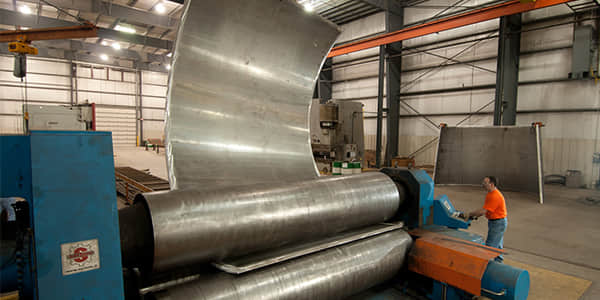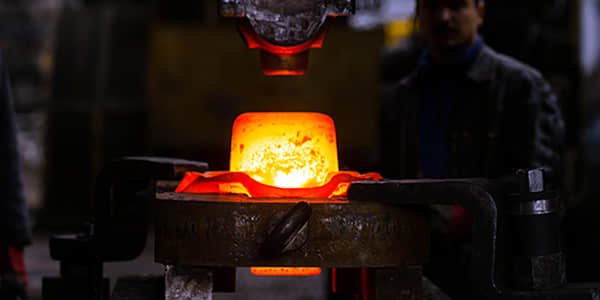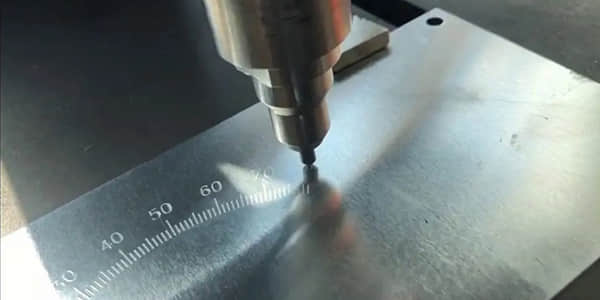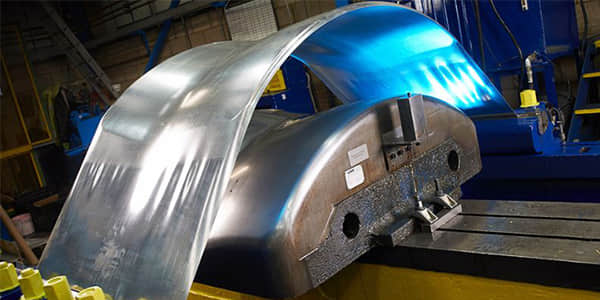What is Steel Forming Process
In brief, steel forming process covers a group of manufacturing processes that reshape metal workpieces through a combination of applied mechanical forces. These processes normally preserve the mass and integrity of the material as it alters its configuration; thus, metal forming is a critical process for producing industrial components.
Such parts include those used in automotive applications, construction materials, aerospace components, and many consumer goods.
Difference Between Hot Work And Cold Work Molding
What is Hot Working?
Hot working is a metalworking process in which the metal is plastically deformed at a temperature above the point at which it begins to reform into new grains. At the corresponding temperature, the working metal is plastically worked, which minimizes the crack formation in hot working when the metal is worked.
Benefits:
- Good ductility allows important deformation.
- Reduction of residual stresses.
- Dynamic recrystallization confers uniform material properties.
Drawbacks:
- It requires great amounts of energy for heating.
- There is a danger of oxidation of the surface, and scaling may also occur.
- Gives less accurate dimensional control.
What is Cold Working?
Cold-working or is the shaping of metal below its recrystallization temperature, generally at room temperature.
Advantages:
- Improved surface finish and dimensional accuracy:
- Increase in strength due to strain hardening.
- Saves on heating cost.
Disadvantages:
- Limited deformation due to decreased ductility.
- Higher wear of tooling, as well as the risk of cracking.
- Requires much larger forces than hot working.
Types Of Steel Forming Processes
Based on the type of stress applied, sheet metal process can be broadly divided into: compressive stress forming, tensile stress forming, and other steel forming processes.
Compressive Stress Forming:
Compressive stress forming is the process of applying compressive loads to change the shape of metal. It is suitable for materials that can endure high deformation without breakage. Here are the major processes present in compressive stress forming:
Rolling:
The thickness of metal is reduced or its cross-sectional area is changed by passing it through one or more pairs of rotating rollers.

Types: ·
- Hot Rolling: Such rolling is conducted above the recrystallization temperature. It is best suited for structural steel and mass production.
- Cold Rolling: The workpiece is subjected to cold rolling at room temperature, which results in an improved surface finish and more stringent dimensional tolerance.
Application:
- Tool for production of steel sheets, plates, bars, etc.
- Used for making automotive body panels and pipelines.
Advantages:
- Efficient for large-scale production.
- Uniform mechanical properties across the material.
Extrusion
Extrusion is the process by which metal is applied through a die to produce objects with a fixed cross-section.

Types of Extrusion:
- Direct Extrusion: Metal is forced through the die in the same movement as the applied pressure.
- Indirect Extrusion: The die goes towards the stationary metal.
- Cold Extrusion: Conducted at room temperature for greater strength of material.
- Hot Extrusion: Conducted at high temperatures for materials with lower ductility.
Applications:
- Extruded Aluminum profiles for use in window and door frames.
- Copper tubing for electrical and plumbing uses.
Advantages:
- This manufacture of extremely complicated shapes with high precision.
- Little wastes are generated in production.
Die Forming
Die forming is the process of reshaping metals by pressing them into a mold or die, in the shape of the die.

Process:
- A metal blank is placed on the die.
- Force is applied by the press to shape the blank.
Applications
- Manufacture of automotive body parts.
- Production of household appliances and containers.
Advantages
- Ideal for high-volume production.
- Achieves consistent and repeatable shapes.
Forging
Forging is the process of changing the shape and internal structure of metal by applying local compressive force (hammering, squeezing, etc.). It is one of the oldest metal forming techniques.

Forging Types:
- Open-die forming: In open-work, the metal is worked without being fully enclosed in the die.
- Closed-die forming: In closed-work, the metal is fully enclosed in a die, giving sharp, precise shapes to the formed part.
- Seamless bearing: Used for manufacturing rings and cylinders without seams.
Application:
- Aerospace components such as turbine blades.
- Automobile crankshafts and gears.
Advantage:
- Strong components.
- Reduced porosity of material.
Indenting
Indenting refers to pressing into the surface of a metal in order to create patterns, textures, or marks without cutting or removing material.

Process:
- The tool or roller would be pressed against the metal surface with high force.
- As the tool passes over, patterns or textures are made onto the surface.
Applications:
- A decorative finish for architectural elements.
- Surface texturing to enhance grip in tools.
Benefits:
- Adds functional or aesthetic utility with no removal of material.
- Simple and cost-effective on some designs.
Tensile Stress Forming
Metal materials will undergo plastic deformation under tensile stress, and the cross-section of the material will gradually decrease while the length will increase. Tensile stress forming takes advantage of this property and shapes the metal by precisely controlling the tensile stress.
Stretching
Material being pulled along the length of a metal part to make it larger, thinner and elongated.

Process:
- Supported workpiece on the edge.
- Pulled until the desired elongation is reached. Applications:
- Used in manufacturing aircraft fuselage panels.
- Forming automobile body parts such as smooth surfaces.
Advantages:
- Components produced with very good surface finish.
- It is possible to precisely control thickness and shape.
Expanding
Expansion involves enlarging the diameter of a hollow workpiece such as a tube or shell by tensile stress application.
Process:
- Expanding from the inside, the hollow workpiece is either expanded with internal pressure or mechanical means.
- The pressure applied causes the material to expand radially.
Applications:
- Manifolding or pipeline production
- Pressure vessels Component production for HVAC systems
Benefits:
- Excellent for continuous cylinder component production
- Uniform wall thickness expansion
Recessing
It refers to sink or recess in a metal surface by introducing tensile stresses over a specific area.
Process:
- A part of the metal surface is drawn down, resulting in a recessed area.
- Shaping tools or dies control the process.
Applications:
- The production of components with pockets or grooves.
- The production of electrical enclosures and housings.
Advantages:
- Localized shaping without affecting the rest of the work.
- Very effective in manufacturing complex surface profile.
Combined Stress Forming
In the method of combined stress forming, both tensile and compressive stresses are applied simultaneously for both intricate shapes and ideal material properties.
Procedure:
- Pulling and pressing forces are applied at the same time into the workpiece.
- This integrating combination can create multi-dimensional shaping.
Application:
- production of components shaped for automobile and aerospace units.
- manufacture of pressurized vessels and storage tanks.
Benefits:
- Achieves the right balance of strength and ductility.
- facilitates fabrication of intricate designs.
Other Steel Forming Processes
Metal forming methods: Steel forming includes a variety of processes, other than compression and tension. These "other" processes are all capable of being performed in a variety of configurations and have certain applications with distinct advantages. Contains the following categories.
Shearing
Shearing is a cutting process that separates metal sheets without forming chips or using melting techniques.
Process:
- A workpiece is placed between a fixed blade and a moving blade.
- High force is applied to cut the material along a straight line.
Applications:
- Cutting sheets into smaller pieces for easy handling.
- Blank preparation for subsequent forming processes.
Benefits:
- Fast and suitable for mass production.
- Very little wastage of materials.
Bending
Bending is the process of reshaping metal to fit into specific angles or curves by exerting a force along a straight axis.
Operation:
- The workpiece is placed over a die or bending tool, a punch presses the Bending tool with force, creating the desired angle.
Applications:
- Fabrication of brackets, frames, and enclosures, and pipe-and-structure factories.
Advantages:
- The process retains the integrity of the material without cutting.
- Large angles up to 360 degrees and any curve will be supported.
Punching
Punching removes specific sections from a metal sheet by applying shear force.
Process:
- A punch and die system introduce shapes or holes into the material.
- The piece punched out is either returned as scrap or is a usable part.
Applications:
- Drilled holes for fasteners or ventilation.
- Metal screen or perforated sheet production.
Advantages:
- Precision and repeatability.
- Ideal for mass production.
Laser Cutting
In this technique, high-energy laser beams are able to perform cutting or engraving of metal to a particular specification.
Process:
- The focused laser beam can melt or vaporize the material, which is removed by a jet of gas, resulting in a very clean cut.
Application:
- Precision cutting of electronic and aerospace components;
- Engraving intricate patterns on decorative and industrial parts.
Advantages:
- Very accurate with clean edges;
- Capable of cutting complex shapes.
Casting
The process of molding is whereby molten metal is poured in a mold cavity and allowed to cool in order to acquire desired shape.
Process:
- First, the metal is melted and poured into a mold cavity. Once cooled, the solidified part is removed for finishing.
Applications:
- The casting technique can be applied in the mass production of automotive and machine parts.
- They can also make complex shapes, and therefore everything from sculptures and tools.
Advantages:
- Casting is ideal for large, complicated components.
- Compatible with a wide variety of metals and alloys.
Welding
Welding melts the edges of two or more metals at the joint. Filler material may be used if required.
Processes:
- Heat or pressure is applied to the edges of the metals.
- Melting metals and solidifying them together to form a strong structure
Applications:
- Manufacturing of structural frames and pipelines
- Repairs of damaged metal parts.
Advantages:
- Heat permanent and strong joints.
- Can be used on several materials and shapes.
Ironing
Ironing is a process for thinning the wall thickness level on cylindrical or flat components.
Process:
- A piece of work, usually a metal cup or cylinder, is forced through a die.
- This process decreases material wall thickness while simultaneously tapering shape.
Applications:
- Manufactures beverage cans and cartridge cases.
- Produce seamless and uniformly walled containers.
Conclusion
Metal forming is the most widely used process in the manufacturing field which involves shaping, forging of metals in order so that they can be converted into useful products. One should have a clear idea of hot and cold working processes and different types of metal-working processes along with knowledge of safety precautions in the production process to avoid accidents or any hazards. This way its production will be easy and safe.
Whether you work in the construction, automotive or aerospace industries, utilizing the correct metal forming process is critical to achieving the desired results.
FAQ
Can custom shapes be achieved through metal forming?
- Yes, processes like die forming, extrusion, and laser cutting are specifically designed to create custom shapes tailored to industry needs.
What materials are suitable for metal forming?
- Most metals, including steel, aluminum, copper, brass, and titanium, can be formed. The choice depends on the application and the specific forming process.
What industries benefit most from metal forming?
- Industries such as automotive, aerospace, construction, electronics, and consumer goods heavily rely on metal forming for manufacturing high-precision and durable components.





